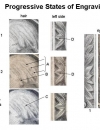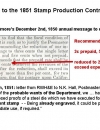
The Research Contributors & The Donation Team: Tom Alexander, James Allen, Tom Bane, Tina Bayer, Michael Bean, Richard Celler, Dr. Charles J. DiComo, Barbara Ford, Mark Friedman, Sonny Hagendorf, Robert Hegland, Tom Hipschen, W. Wilson Hulme, Larry Hunt, James E. Lee, Barbara Mueller, Mike O’Reilly, Stanley Piller, William Snyder, Mark Tomasko, George Tyson, Roy P. Weber, Stephanie Weber, William Weiss, Jr.
Study Coordinator: Roy P. Weber. If you would like more information on this research and its output, please contact Dr. Charles J. DiComo
Click to show/hide thumbnails of the 11-E2 Study. Click a thumbnail to zoom in.
The hand engraved steel die for the Scott Catalog designated 11-E2 Essay was purchased by a consortium of thirteen collectors and donated to the Smithsonian National Postal Museum (NPM). The Scott Catalog states that the 11-E2 Essay is from 1851 and “attributes” it to Rawdon, Wright, Hatch & Edson (RWH&E).
After a decade of persistence by Dr. Charles J. DiComo and this study group, the 2017 Scott U.S. Specialized Catalog was updated to denote the proper attribution of the Henry C. Benner Essay 11E2.
As for the other 1851 Essays, work still needs to be done to have well founded answers to the problems that have been found with several other Scott Catalog listings.

Careful examination of the nine known examples of the Essay, plus sixteen prints recently made from the die, reveals that the essays come from two progressive states of engraving. Dozens of lines were added or strengthened between the first and second states. Modern prints can be identified by a rust mark in Washington1s hair. We present in Chapter 6 an inventory of all known 11-E2 Essays. Chapter 7 covers in detail the progressive states of the engraving.

Chapter 9 shows substantial evidence that the 11-E2 Essay was not from the firm of Rawdon, Wright, Hatch & Edson. We review the key points here:
a) Government documents show that RWH&E initially refused to participate in the 1851 bidding process and then was denied the delay it requested for submitting a bid. [RWH&E letters; Travers papers]
b) RWH&E tried to resubmit the 11-E1 Essay, which we show was originally proposed by them for the 1848 prepaid three-cent newspaper rate, for a temporary 1851 three cent stamp. Documents show that RWH&E believed the permanent rate would be two cents and the portrait of Washington should be preserved for that rate. [RWH&E letters]
c) To date, the 11-E2 Washington head has not been found on any bank notes or other documents. Students of bank note engravings, including Mark Tomasco, the Honorary Curator of Engraving at the Museum of American Financial History, and Richard Doty, Curator of Numismatics, Museum of American History, have never before seen this engraving of Washington. Bank note engravers, especially RWH&E, reused their engravings. [Mark Tomasco; Richard Doty]
d) Members of the Smillie family, several of which were noted engravers, collected die proof portraits and vignettes from many of the bank note engravers of their era. The 11-E2 Washington head did not appear in the Smillie material that was sold at Alderfer1s Auction Company or in the Smillie notebooks or scrapbooks. [Mark Tomasco]
e) All known 11-E2 Essays appear only in black. Other essays from the companies that merged into the American Bank Note Company, including RWH&E, were later printed in multiple colors and on multiple types of paper. [Brazer, Essays for U.S. Adhesive Postage Stamps]
f) The 11-E2 steel die was not in the vaults of the American Bank Note Company when it sold its essays and proofs. Steel dies for three other 1851 essays were there and are now owned by Arthur Morowitz. [Arthur Morowitz]
g) The styles of engraving, including the lettering and numbering, on the 11-E1 Essay and 11-E2 Essay are different.
h) The 11-E2 engraver did not make use of a geometric lathe, a security engraving device used by bank note printers such as RWH&E at that time.
i) The only reason the 11-E2 Essay is “attributed” to RWH&E is that Mason in 1912 said “the frame resembles the 5 cent and 10 cent stamps of 1847.” The trouble with this argument is that the 1847 issues were the only examples of designs acceptable to the Post Office Department that an engraver had to work with. [Mason, More Essays for U.S. Postage Stamps, 1912]
j) Richard Doty, Curator of Numismatics, Museum of American History, does not think 11-E2 was engraved by RWH&E. He said, “The work is too good, the portrait too sensitive.” [E-mail from Richard Doty]
Chapter 10 shows substantial evidence that the 11-E2 Essay was submitted to the Postmaster General in 1851 by Henry C. Benner, a Washington, D.C. engraver and printer. We review the key points here:
a) Government documents show that “Henry Benner, of Washington, D.C.,” was one of seven bidders for the 1851 stamp production business. He was not invited to bid, but “upon his application put in a proposal.” [Travers Papers]
b) The bidders were required to submit an engraved design for a three-cent stamp with the head of Washington in profile and the words “U.S. Postage, Three Cents” in “pure white” letters. The 11-E2 Essay conforms to these requirements. [PMG Letter]
c) The dimensions and engraving style of the 11-E2 steel die are consistent with being produced in the 18501s. [Tom Hipschen, BEP; Michael Bean, BEP]
d) Henry C. Benner (c1813 – 1863) is listed as an engraver in the 1850 – 1860 Washington City Directories. In the 1835 – 1846 Philadelphia City Directories he is listed as a copperplate printer. He worked from 1843 until 1850, when he was “dismissed”, for the U.S. Coast Survey Office as a printer. [Washington City and Philadelphia Directories; U.S. Archives – Coast Survey Office Personnel Files]
e) Frederick Dankworth (1804 – 1859), related to Henry C. Benner by the marriage of their children, also worked for the U.S. Coast Survey Office and also moved from Philadelphia to Washington, D.C. He was an engraver. [Philadelphia and Washington City Directories; Census; Cemetery Records; U.S. Archives – Coast Survey Office Personnel Files]



i) In his will, Samuel Tiller left his printing business and all property used to carry out that business to Edwin Benner. The inventory of his Printing Office at the time of his death in 1880 included “Old Fashioned Plate Printing Presses” and “Old Engraved Metal Plates S one half of which is the property of E. Benner.” [Philadelphia City Archives – Register of Wills]

k) William Snyder of Holland, Pa., the previous owner of the 11-E2 steel die, told us that his grandfather, Willard Snyder (1907 – 1999) may have obtained the die from Fisher Vanderslice, a friend and auctioneer. Willard Snyder ran a Stamp and Coin business in Philadelphia. His home at the time of his death was in West Mount Airy, Pa. [E-mails from William Snyder; Philadelphia directories]


n) Franklin Fisher Vanderslice (1893 – 1975) was a member of the Numismatic and Antiquarian Society and was known there as F. Fisher Vanderslice. His sister Frances Alice Vanderslice married Henry Lewis Benner late in life and they had no children. Henry Lewis Benner inherited a substantial amount of money from his father Andrew Penrose Benner, an architect, and from Samuel Tiller Benner, a builder. Henry Lewis Benner left everything to his wife in his will. Frances Alice Benner lived with her brother Franklin Fisher Vanderslice after Henry Lewis Benner died and until she died. She left everything to him in her will. Franklin Fisher Vanderslice never married. His substantial estate, which included a considerable collection of antiques, was left to a friend. His family was specifically excluded from his will. [Census; Philadelphia City Directories; Obituaries; Cemetery Records; Historical Society of Pennsylvania – Numismatic and Antiquarian Society; University of Pennsylvania Alumni Records; Phoenixville Historical Society; Montgomery Co., PA Archives]
o) The Benners owned a 2 story brick building, located at 1235 Locust Street in Philadelphia, from 1857 until 1965. Samuel Tiller owned 1233 Locust Street from 1830 until 1864. 1235 Locust Street was the address that Henry Lewis Benner used in a 1920 document and Edwin Benner used in 1867 and 1913 documents. In 1935 Henry Lewis Benner listed it as his home in the Philadelphia directory. The last Benner to own the property was Frances Alice (Vanderslice) Benner. Franklin Fisher Vanderslice sold it at auction when she died in 1965. Willard P. Snyder1s Safe and then Coin and Stamp businesses, from 1936 until 1976, were located at a sequence of five Philadelphia locations. His third store, from 1940 until sometime between 1950 and 1954, was located at 1309 Walnut Street, which is less than two blocks from the Benner property. [Philadelphia City Archives – Register of Wills; Obituaries]
p) Five 11-E2 Essays were purchased in 1998 by Wayne Gehret, an ASDA stamp dealer, at Alderfer1s Auction Company in Hatfield, Pa. as part of a common two volume world-wide stamp collection. The consigner and the auction house clearly had no idea of what they were selling. [Wayne Gehret]
q) Early states of stamp and essay engravings, such as the 11-E2 Essays that were sold at Alderfer1s Auction Company, were frequently saved by engravers. Such family keepsakes were hunted and found by Clarence Brazer and others. Most likely, in 1998 the 11-E2 engraver1s descendants lived near Alderfer1s Auction Company in the Hatfield, Pa. area. [Mark Tomasko; Jim Lee; Clarence Brazer1s files]
r) Phoenixville (the Vanderslice family homestead and where Franklin Fisher Vanderslice and Frances Alice Benner are buried), West Mount Airy (where Willard P. Snyder lived), Hatfield (location of Alderfer1s Auction Company), Holland, Pa. (home of William Snyder), Ambler, Pa. (home of Henry Lewis Benner, Frances Alice Benner, and Franklin Fisher Vanderslice), and Fort Washington, Pa. (home of Quintin Mecke, II) are all within a circle whose radius is 15 miles, just northwest of Philadelphia (where Willard P. Snyder had a Coin and Stamp store and where the Benner home was located).
s) The 11-E2 steel die does not appear to have been made by a bank note printer. A geometric lathe was not used and the Washington portrait has not been found elsewhere. The Benners, Samuel Tiller, Frederick Dankworth, and John Sartain were not bank note engravers and would not have had access to a geometric lathe.
Based on the above facts and conclusions, the ownership chain of the 11-E2 steel die was:
- Henry C. Benner
- Samuel Tiller
- Edwin Benner
- Andrew Penrose Benner
- Henry Lewis Benner
- Frances Alice Vanderslice Benner
- Franklin Fisher Vanderslice
- Willard Snyder
- William Snyder
- 11-E2 Consortium
- Smithsonian National Postal Museum

Collaborating with Henry C. Benner in the engraving and/or bidding might have been Samuel Tiller, Frederick Dankworth, Joseph Walter, or John Sartain. They were all extended family members in the engraving and/or printing business in 1851.
We recommend that the Scott Catalog be updated to reflect the facts that the 11-E2 Essay comes in two states and there are 16 modern prints, and the conclusion that Henry C. Benner, of Washington, submitted the 11-E2 Essay to the Postmaster General in 1851. Also, we recommend that the Scott Catalog no longer just “attribute” the 11-E1 Essay to RWH&E, but state that it was “by” them.

























